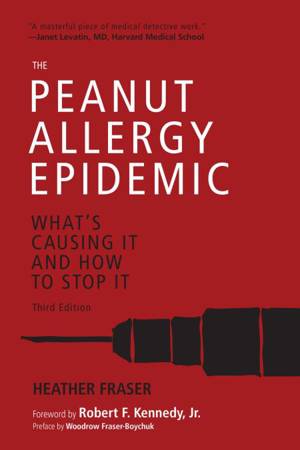
- Retrait gratuit dans votre magasin Club
- 7.000.000 titres dans notre catalogue
- Payer en toute sécurité
- Toujours un magasin près de chez vous
- Retrait gratuit dans votre magasin Club
- 7.000.0000 titres dans notre catalogue
- Payer en toute sécurité
- Toujours un magasin près de chez vous
The Peanut Allergy Epidemic, Third Edition EBOOK
What's Causing It and How to Stop It
Heather Fraser
Ebook | Anglais
14,53 €
+ 14 points
Format
Description
Essential reading for every parent of a child with peanut allergies—third edition with a foreword by Robert F. Kennedy, Jr.
Why is the peanut allergy an epidemic that only seems to be found in western cultures? More than four million people in the United States alone are affected by peanut allergies, while there are few reported cases in India, a country where peanut is the primary ingredient in many baby food products. Where did this allergy come from, and does medicine play any kind of role in the phenomenon? After her own child had an anaphylactic reaction to peanut butter, historian Heather Fraser decided to discover the answers to these questions.
In The Peanut Allergy Epidemic, Fraser delves into the history of this allergy, trying to understand why it largely develops in children and studying its relationship with social, medical, political, and economic factors. In an international overview of the subject, she compares the epidemic in the United States to sixteen other geographical locations; she finds that in addition to the United States in countries such as Canada, the United Kingdom, Australia, and Sweden, there is a one in fifty chance that a child, especially a male, will develop a peanut allergy. Fraser also highlights alternative medicines and explores issues of vaccine safety and other food allergies.
This third edition features a foreword from Robert F. Kennedy, Jr. and a new chapter on promising leads for cures to peanut allergies. The Peanut Allergy Epidemic is a must read for every parent, teacher, and health professional.
Why is the peanut allergy an epidemic that only seems to be found in western cultures? More than four million people in the United States alone are affected by peanut allergies, while there are few reported cases in India, a country where peanut is the primary ingredient in many baby food products. Where did this allergy come from, and does medicine play any kind of role in the phenomenon? After her own child had an anaphylactic reaction to peanut butter, historian Heather Fraser decided to discover the answers to these questions.
In The Peanut Allergy Epidemic, Fraser delves into the history of this allergy, trying to understand why it largely develops in children and studying its relationship with social, medical, political, and economic factors. In an international overview of the subject, she compares the epidemic in the United States to sixteen other geographical locations; she finds that in addition to the United States in countries such as Canada, the United Kingdom, Australia, and Sweden, there is a one in fifty chance that a child, especially a male, will develop a peanut allergy. Fraser also highlights alternative medicines and explores issues of vaccine safety and other food allergies.
This third edition features a foreword from Robert F. Kennedy, Jr. and a new chapter on promising leads for cures to peanut allergies. The Peanut Allergy Epidemic is a must read for every parent, teacher, and health professional.
Spécifications
Parties prenantes
- Auteur(s) :
- Editeur:
Contenu
- Nombre de pages :
- 272
- Langue:
- Anglais
Caractéristiques
- EAN:
- 9781510726321
- Date de parution :
- 05-06-17
- Format:
- Ebook
- Protection digitale:
- Adobe DRM
- Format numérique:
- ePub

Les avis
Nous publions uniquement les avis qui respectent les conditions requises. Consultez nos conditions pour les avis.






